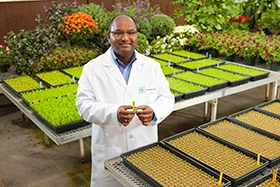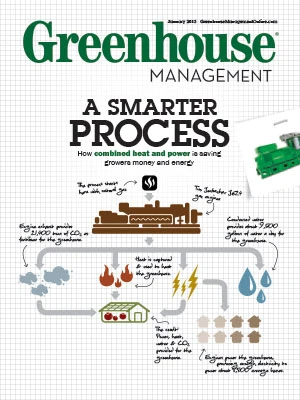
 Vijay Rapaka is the manager of Grower Research at Smithers-Oasis in Kent, Ohio. Photo courtesy of Yasaki Photographic. Vijay Rapaka is the manager of Grower Research at Smithers-Oasis in Kent, Ohio. Photo courtesy of Yasaki Photographic. |
From peat to rice hulls, many options are available when it comes to growing media, and several factors play a part in deciding what is best for your growing needs. In this package, experts take a look at three aspects of this topic: choosing the best propagation growing media, soil wetting agents and research initiatives. Read on to learn more this area in production.
Rooted in success
Essential keys for choosing the best propagation growing media
By Vijay Rapaka
Rooting success relies on a very delicate balance between air and water. When choosing the correct growing media product, it is critical to understand that equilibrium to achieve consistent results during propagation. Additionally, several other key factors will help a grower be successful.
First, and most importantly, you can root just about any plant if you balance the air and water of the media properly. Typically, growers have a tendency to over-apply mist during propagation which can delay the rooting of the cuttings. Choosing a growing media with higher air porosity can improve the air-to-water ratio and promote faster rooting. Conversely, media with lower air porosity requires less misting during propagation. In either case, it is critical that the grower never let the cuttings wilt during the initial phase of propagation as it jeopardizes the cuttings survival.
Next, there are two main types of propagation growing media: stabilized and loose. Stabilized growing media include foams, peat or polymer-based, paper-wrapped, compressed peat or coir products. By their very nature, stabilized propagation media are bound together as a solid unit and, therefore, do not require an extensive root system to transplant. On the other hand, loose media — which often contain a combination of peat, perlite, vermiculite and coir — require well-formed root systems, and therefore take more time to achieve a transplantable root ball.
 Stabilized media can be transplanted earlier than loose-filled media. Photo courtesy of Smithers-Oasis Stabilized media can be transplanted earlier than loose-filled media. Photo courtesy of Smithers-Oasis |
The growing media tray influences the microenvironment around cuttings, as well. Select a tray with vent holes that allow airflow around the base of the cuttings to help prevent disease. Also, use a tray configuration that matches the leaf canopy of the crop and avoid over-crowding.
Many growing media manufacturers offer customized options for specific growing needs, from media with different drainage levels, to those with different pH levels. Growers should seek companies that offer a variety of options to fit their needs, as well as those of their specific crops. Plus, growing media manufacturers are always researching ways to help make the lives of growers easier. Flexible, high-efficiency products are always emerging. Some new products have even been purported to reduce propagation cycle time by up to 25 percent.
Finally, consistency is key to any good product. Grower supply specialists glean experience from their customers. Ask which growing media are the most consistent. Word-of-mouth praise about a product is some of the best advice out there.
Vijay Rapaka is the manager of Grower Research at Smithers-Oasis, an Ohio-based manufacturer of propagation media and floral foam. He holds a doctorate in horticulture plant physiology.
|
Experts on: Choosing the best growing media GROWERS SHOULD be aware that air space in the media is just as important as the germination/propagation media. Growers who face the dilemma of low-light and low-drying conditions will continually face the issues of soil-introduced diseases. Not soil-borne diseases, but diseases that are attracted to high moisture, low light, low air movement and slow-drying conditions. Media with a good soil-to-air ratio will always serve the growers needs best. — Jeff Bishop, sales representative, Lambert Peat Moss Inc.
— Mark Shepherd, eastern regional sales manager, Riceland Foods |
Wetting agents: fact and fiction
Blowing up misconceptions about wetting agents and moisture conditions.
By Brian Cantin
Acommon belief is wetting agents cause a media to hold onto too much water. In reality, wetting agents balance moisture conditions and provide a uniform growing environment.
First, a little science behind these products. Wetting agents are added to soilless mixes to ensure water moves uniformly and quickly throughout media.
 In untreated media, water repellant components, such as peat and bark, prevent uniform wetting. Irrigation water is repelled by these particles and portions of media will remain dry even after heavy irrigation.
In untreated media, water repellant components, such as peat and bark, prevent uniform wetting. Irrigation water is repelled by these particles and portions of media will remain dry even after heavy irrigation.
Since wetting agents reduce run-off and run-through, it often appears as though the soil is holding too much water. This leads to the misconception that wetting agents increase water holding capacity. Wetting agents — because they cause water to disperse — allow for better wetting without causing over-wet conditions.
Most, if not all, basic plant functions including photosynthesis, plant metabolic functions and gas exchange all tie back to adequate water supply.
Wetting agents assist in controlling water infiltration, water distribution and drainage, thus affecting moisture reserves, nutrient availability and aeration. By preventing water masses from building up, they prevent oversaturation and increase air-to-water ratios in the root zone. If the media remains saturated for a prolonged period of time, the root environment becomes a breeding ground for several root rot pathogens. By maintaining a balanced air-to-moisture level in the media, plant stress is greatly reduced; healthier and stronger plants develop that are more resistant to disease. Consequently, anything that is distributed by water — e.g. pesticides, fungicides and fertilizers — will be more uniformly delivered throughout the media increasing efficiency of those products.
Recharging the media with a wetting agent prepares the plants for the retail environment. By the end of the production cycle, the water-repellant behavior of certain components can become an issue due to repeated drying in the sometimes harsh retail environment. An application of wetting agent at this time ensures the wetting ability of plants, even when they are allowed to dry out.
Wetting agents reduce water repellency, improve uniform movement and distribution of water and allow the root zone to maintain the correct level of moisture throughout the growing cycle. This is important for efficient water management in plant production and can also be an important factor in postharvest care and the shelf life of plant material.
Brian Cantin is a grower advisor at Berger. He holds an Honors Science Degree in environmental horticulture.
|
Experts on: Using soil wetting agents GROWERS SHOULD be aware of the half-life of the product and the inability of peat moss to absorb water after the wetting agents have lost their efficacy. Often a grower will not be as judicious as they should be when rotating their growing mixes. They should be more aware of the production dates of when the mix was made since most wetting agents have a shelf life of no longer than eight months. The life span of wetting agents depends on where the products are stored. Typically, when the bales of bags of media are placed in the sun, heat shortens its viability. It’s a good practice to inject small dosages of wetting agents into their irrigation so media percolate well and allow for good air space. — Jeff Bishop, sales representative, and Otto Kaufmann, regional sales manager, Lambert Peat Moss Inc.
— Mark Shepherd, eastern regional sales manager, Riceland Foods |
New initiatives
Sun Gro’s research program focuses on growing media solutions
By Hugh A. Poole
In June 2012, the technical team of Sun Gro Horticulture combined resources with the research program of Conrad Fafard to form a unique opportunity in our industry. The combined program utilizes the talents and experiences of individuals with strong technical, research and practical production knowledge. The research program is being coordinated at the Sun Gro Discovery Center in Anderson, S.C.
 A major research initiative is to identify alternative components for soilless substrates that are locally available and are sustainable in the future. With facilities across North America, the term “local” covers many possibilities. We’re trying to identify the physical and chemical attributes of these components to better screen them in regards to performance and overall cost. Past research has focused on rice hulls and chipped pine tree as media components. A better understanding of these components will allow us to review other possible wood substrates and green composts for future consideration.
A major research initiative is to identify alternative components for soilless substrates that are locally available and are sustainable in the future. With facilities across North America, the term “local” covers many possibilities. We’re trying to identify the physical and chemical attributes of these components to better screen them in regards to performance and overall cost. Past research has focused on rice hulls and chipped pine tree as media components. A better understanding of these components will allow us to review other possible wood substrates and green composts for future consideration.
Our customers are looking at products that can be incorporated into their soil mixes that will reduce overall costs, reduce shrinkage in the marketing channel and/or prolong the performance of the plants for the ultimate consumer. These additives include biological agents, fertilizer sources (traditional and organic), water-retention products and active ingredients for the control of insects and diseases. Growers are concerned with fertilizer run-off issues. A better understanding of fertilizer usage and costs can reduce pollution and provide a better offering to the consumer.
Our technical team receives numerous requests for seminars and answers to practical questions regarding plant growth. The program addresses many of these concerns. We’ll have the opportunity to provide both tools and training aids to respond to the growers’ concerns in a practical and professional manner.
Another goal of the program is an on-going effort to evaluate our research processes in order to provide good, quick answers to our management team on new products or concepts. We need to evaluate opportunities quickly and thoroughly. Identifying a new product that will fail quickly is just as important as researching a new concept and introducing it to the marketplace quickly.
This program has had the opportunity to work with 100 growers across the country over the past five years, and has provided great insight into growers’ concerns and practical experience in tackling these issues.
Hugh A. Poole is a director of research and development for the Sun Gro Discovery Center. He holds a doctorate in horticulture.

Explore the January 2013 Issue
Check out more from this issue and find your next story to read.
Latest from Greenhouse Management
- Anthura acquires Bromelia assets from Corn. Bak in Netherlands
- Top 10 stories for National Poinsettia Day
- Langendoen Mechanical hosts open house to showcase new greenhouse build
- Conor Foy joins EHR's national sales team
- Pantone announces its 2026 Color of the Year
- Syngenta granted federal registration for Trefinti nematicide/fungicide in ornamental market
- A legacy of influence
- HILA 2025 video highlights: John Gaydos of Proven Winners





